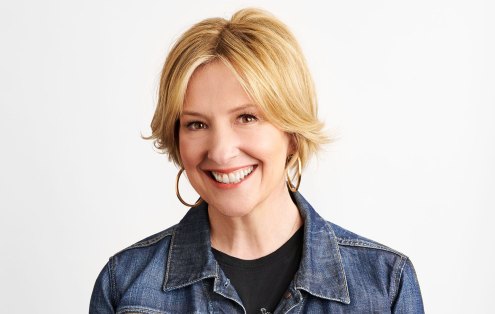A happy, hygge state of mind
There is a lot more to the Danish art of cosy than interior design – it’s a philosophy for better living. Andréa Childs uncovers its secrets

The Danish concept of hygge did not seem like much of a mystery to me. It was a view filtered through the lens of interiors magazines, which represent hygge as a soft take on Scandi home design – with unlimited tea lights, a cosy throw draped over a sofa, and a brimming mug of cocoa. It is all of those things but, as I’ve discovered, it’s also a whole lot more.
‘Hygge is an experience of selfhood and communion with people and places that anchors and affirms us, and gives us courage and consolation,’ says Louisa Thomsen Brits in The Book Of Hygge: The Danish Art Of Living Well (Ebury Press, £12.99). Suddenly, I understand that hygge is less about stylish living, more about living better; at home, at work, and within a community.
My days can often feel sharp and fractured. My family busy in separate rooms; my job is often solitary; politics and the news are full of uncertainty and hard truths. Perhaps hygge is the thread that can entwine my life with those around me, and draw us closer?
I need to understand hygge better, and learn to translate it for my own life; starting with how to pronounce it (it’s hue-gah, kind of a mix between ‘hurrah’ and a sneeze). ‘Language helps us shape our behaviour. Just using the word hygge will make us more aware of it as an option,’ says Meik Wiking, CEO of the Happiness Research Institute in Denmark (the country measured to be the happiest in the world, and probably not coincidentally).
So, I’m going to learn to hygge-snakke (hygge-chat) in the corner shop; enjoy a hyggeaften (hygge evening) with friends; and wish my children ‘Hyg dig!’ (‘Have hygge!’) as they walk out the door. And it all starts with three hygge principles: pleasure, presence and participation.
A sensory experience
‘When it comes to hygge, we need to engage all our senses,’ says Wiking, who is also the author of The Little Book Of Hygge (Penguin Life, £6.99). He tells me about a night he spent on an island in Denmark this summer. ‘I think it is the most beautiful spot in the world,’ he says.
‘I felt a profound pleasure in the scent of the earth and the feel of the wind. These incredible moments happen only occasionally and, when they do, it’s our emotions and senses that enforce them.’
It reminds me of the days I spend on the beach, with the sun on my face, listening to the sound of the waves. I realise there’s a reason I sit against the sun-warmed groyne, rather than adrift, like flotsam, on the shingle. ‘The theme of an enclosed, secure space is totally intrinsic to hygge,’ says Thomsen Brits. ‘These protective boundaries lend the possibility of savouring the moment, undisturbed.’
She explains how Danes create hygge hjorne – hygge corners – that draw them to different spots in the house; to enjoy the embrace of a cosy chair, or to shield themselves from the chill of loneliness.
I identify the armchair in my living room as a hygge hotspot waiting to happen. I clear the side table of clutter, add a cushion and draw the footstool closer. Later on, I find my husband ensconced in the chair with a cup of tea and the newspaper. In our bedroom, I clear the clothes flung over another armchair and cuddle up with my daughter to read a bedtime story under a blanket. It feels a lot more restful than our usual, ‘squeeze into her bunk bed’, night-time routine.
Thomsen Brits talks about hygge as a return to ‘the scripts we’ve inherited’; in which we revisit those places and people that make us feel whole and rooted. I think back to the story-time ritual I shared with my mother, sitting together as she read The Jungle Book to me, and I realise I’ve recreated this moment; it’s part of my hygge DNA.
Wholeheartedness
There’s an element of mindfulness in hygge; the idea that we are engaged in the present. ‘Hygge is uncomplicated noticing; joie de vivre,’ says Thomsen Brits. ‘We enter wholeheartedly into the moment and taste all that it has to offer.’ It sounds wonderful in principle, but I find it difficult to hold on to this level of awareness in my daily life.
I turn to Wiking for inspiration. ‘It’s about seeking simple pleasures, every day,’ he tells me, explaining the positive impact of ordinary rituals. So, I ask my children to take turns lighting a candle on the dinner table (‘Candles are a hygge cliché, but it’s a signal to slow down, that you want that moment of intimacy,’ says Thomsen Brits).
I turn my daily scan of The Guardian online into a mini hygge moment; with fresh coffee in my favourite mug, and a few flowers from the garden on my desk. But the change that makes the most impact is asking the family to greet each other properly when anyone comes home: no shouting, ‘Hi!’ from in front of the TV; no, ‘Be with you in a minute’, while dashing off an email.
We take a few minutes to connect; asking how each other’s day has been. The house soon seems warmer and friendlier. ‘Hygge in all its forms is a brief moment of pause,’ says Thomsen Brits. ‘It’s not an escape; it’s small moments that make a big difference to how we live, feel and interact.’
Interaction is integral to hygge. ‘It’s about expanding your comfort zone to include others, and to feel that we’re as safe in this small group as we are when we are alone,’ explains Wiking.
I realise I’ve already taken steps to broaden my outlook and lower the drawbridge of the family ‘castle’. We rarely used to host friends at home; now we regularly have people over for lunch followed by board games (‘totally hygge’ says Thomsen Brits).
‘The Danes think getting together is important and they make time to do it,’ says Charlotte Abrahams in Hygge (Trapeze, £20). ‘Have lunch with your colleagues weekly; make Wednesday night friends’ night. Timetabling life may not feel spontaneous, but it means that you see those who matter to you.’
Finding the positive
Hygge is also about finding comfort in a hostile world. I resolve to seek out good news, not just scary headlines; to start a coffee club of writers, to share successes, not just moans; to join local initiatives (the befriend-a-neighbour scheme) that I once claimed I was too busy for. ‘Hygge helps us find a sense of belonging – by connecting with others and ourselves, so we feel embodied and emboldened,’ says Thomsen Brits.
And you don’t have to live in Denmark to feel that. Hyg dig!
Photograph: iStock








